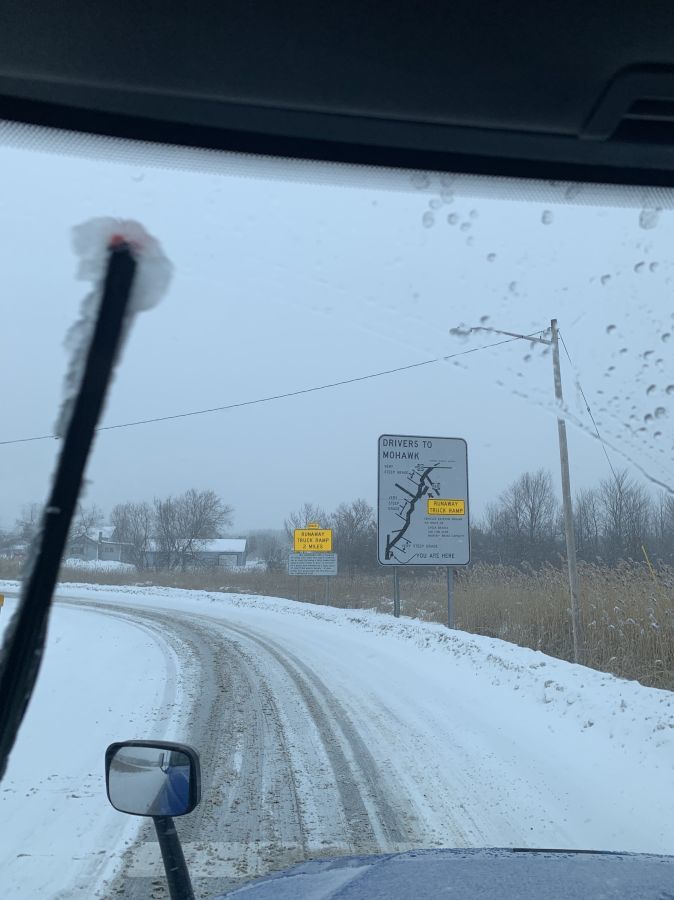How Dangerous Is A Jake Brake In Poor Road Conditions?
Topic 27604 | Page 4
Forgot to add the picture. Imagine trying to read that sign while moving. Lol
Your buttcheeks are cramping...shoulders are screaming at you....what does that sign say???? I'm with you on this Grumpy....
Question - the down shifting in automatics yall keep talking about, is it the same as a 10 speed? Rev to rpm the down shift? How is this accomplished without a clutch? Never driven the autos before just stick....was wondering
For downshifting, just press a button, or move a lever one "click".
Computers running throughout the ECM (Engine Control Module) will prevent too many RPMs through various automatic safety programs, so it is virtually impossible to harm an engine by having the RPMs too high.
At 2500 RPMs the engine is screaming. Considering normally it never goes above 1700, I chicken out and grab the brakes for a second. Lol
"Always?" If it's dry, not necessary to invoke manual mode, bypassing the auto-shift operation.
In the newer "auto-shift" trucks, cruise control and the engine brake (Jake) are electronically linked. Called "Drive Wyze" (on Swift equipment), this control is programmable and may vary slightly from truck to truck. Most of the major carrier have this type of control system on their newer, auto-shift trucks.
At a high level it works like so; set cruise for 65 mph and the system will maintain that speed invoking the engine brake as the speed approaches 69, such as it occurs descending a steep grade. As a rule, when I am running in the mountainous terrain of North Eastern PA & NJ (Interstates 80, 81, 84, 78, PA-TP NE Extension, etc), as I approach a downhill grade I will reduce the speed setting to about 60-62 mph (depending on grade steepness) so I can maintain control descending the hill. The system will invoke the Jake in whatever intensity required (low, med. or high) to control the truck, holding no more than 4 mph above the set speed. As the terrain flattens out, I'll resume the cruise setting to 65. It is very, very rare that I will need to assist with the service brake/ disabling cruise. As such, when cruise is set to "off" or "cancelled", manual application of the engine brake is required.
All of the above is NOT applicable in wet or snowy conditions.
My bad, the advice I'd read on here about always putting it in manual mode for steep grades was specific to road conditions where you can't use engine braking. Hearing the company might disable the manual mode left me wondering how that plays out in rain and ice and snow on those steeper downgrades... in that scenario does the computer system detect the grade and keep it in the right gear for the descent? Or if it doesn't, what's the best approach to take to get down safely?
That's a nice bonus the cruise control is integrated so well with the engine braking. Does Swift disable the manual mode?
Interstate:
Commercial trade, business, movement of goods or money, or transportation from one state to another, regulated by the Federal Department Of Transportation (DOT).
HOS:
Hours Of Service
HOS refers to the logbook hours of service regulations.Your question was the reason for my original question. Without a manual mode on the trans and no jack brake or cruise because of conditions the only way to descend safely is to apply Service bakes until your 5 mph below your “safe speed” then let it coast until you hit your safe speed and re-apply to get back to 5 below. Again, we can also force a downshift but will need to apply service brakes to hold the gear. The manual will want to coast down a hill which is pros good thing in general because they always say to get off the power and let it coast when a wheel starts to slip until you get it under control.
New Reply:
New! Check out our help videos for a better understanding of our forum features

















Preview:
This topic has the following tags:
Adverse Conditions Advice For New Truck Drivers Automatic Transmissions Jake Brake Tips For Braking Tips For Shifting Truckers Technology








 TT On Facebook
TT On Facebook
For downshifting, just press a button, or move a lever one "click".
Computers running throughout the ECM (Engine Control Module) will prevent too many RPMs through various automatic safety programs, so it is virtually impossible to harm an engine by having the RPMs too high.